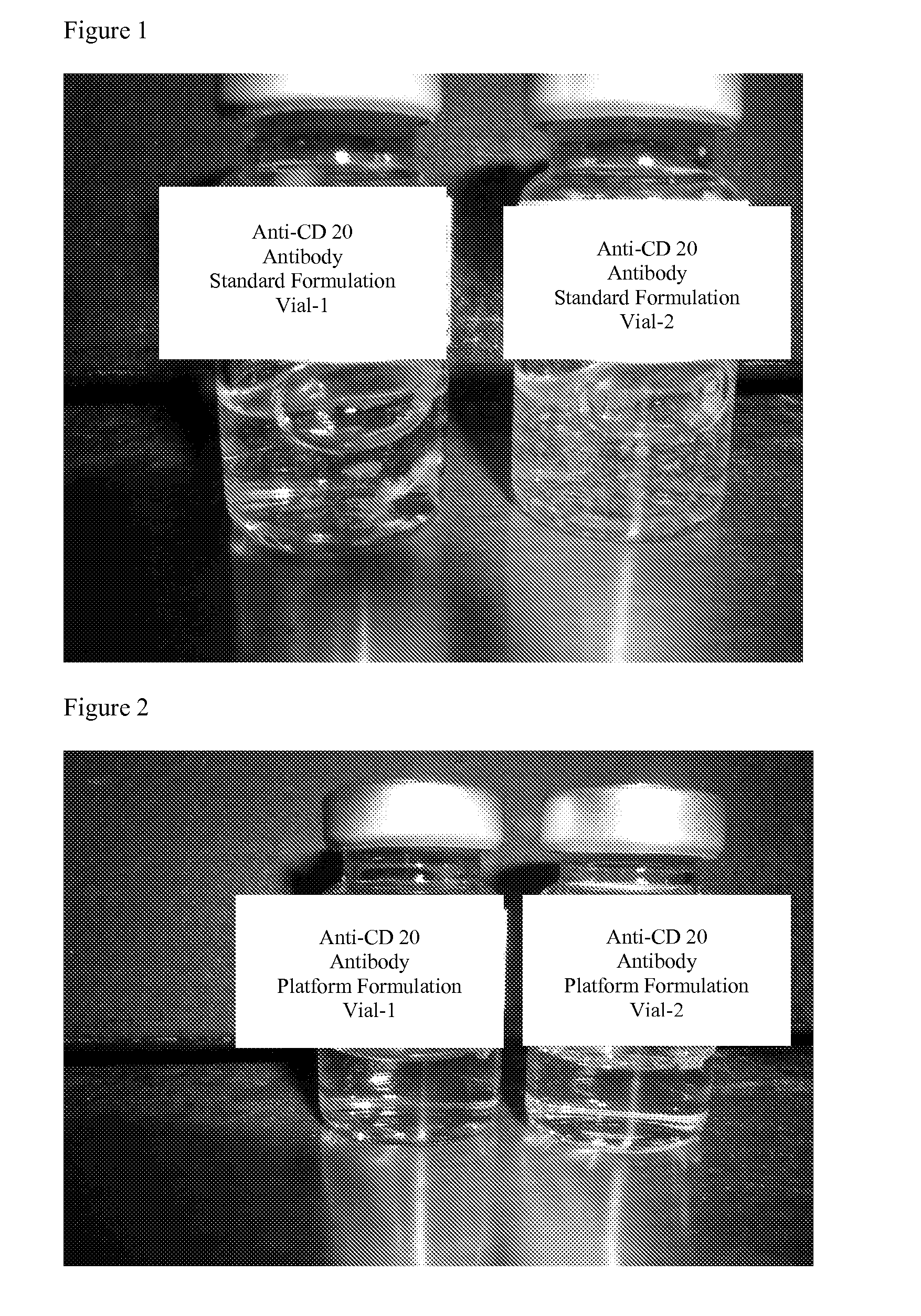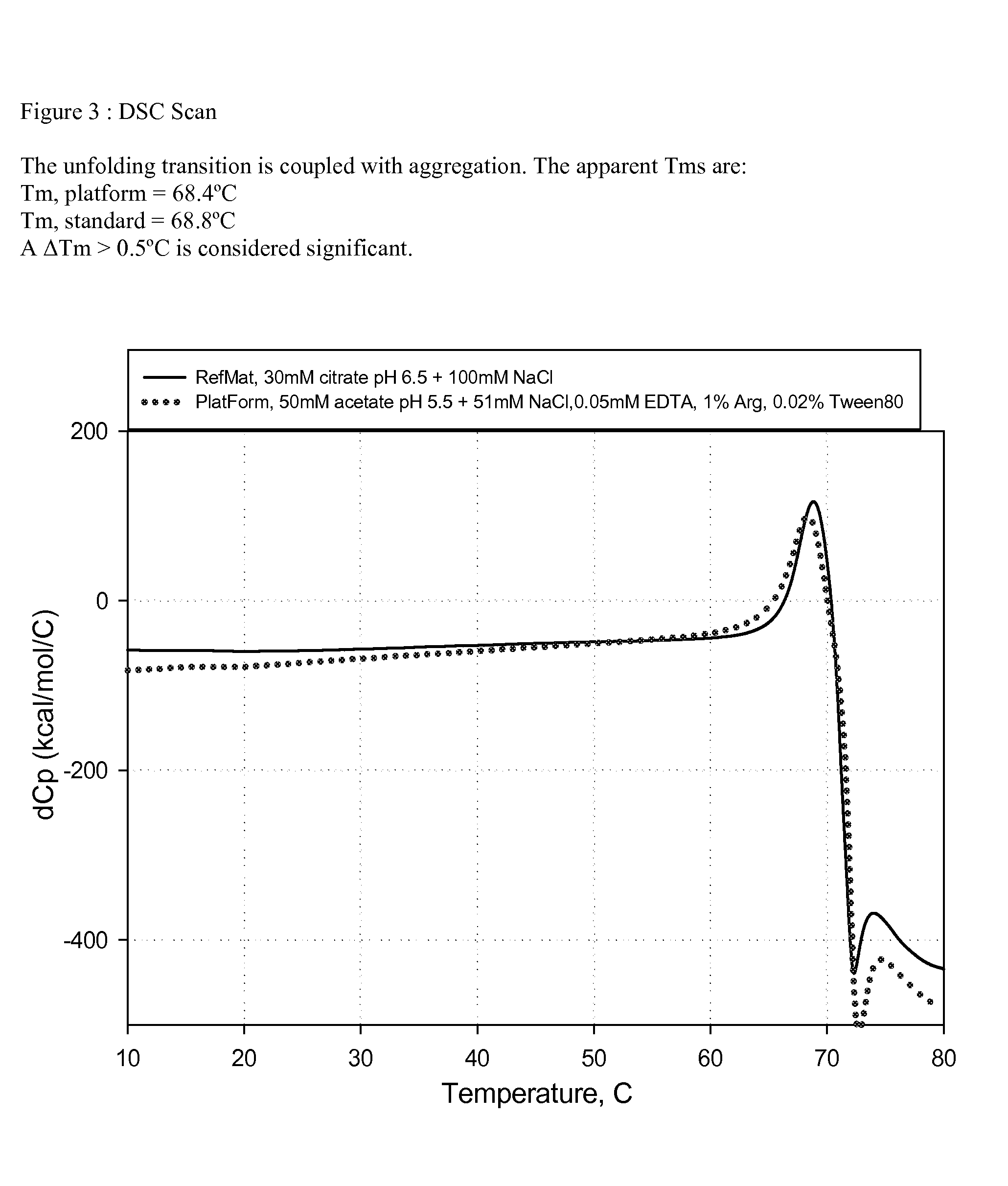Antibody formulations
a technology of antibody and formulation, applied in the field of antibody formulation, can solve the problems of chemical instability, protein posing special problems, large protein and complex structure, etc., and achieve the effects of promoting functional recovery, and reducing the risk of cell death
- Summary
- Abstract
- Description
- Claims
- Application Information
AI Technical Summary
Benefits of technology
Problems solved by technology
Method used
Image
Examples
example 1.1
Preparation of the Platform Formulation Buffer
[0061]In one embodiment of the invention, 4 liters of acetate buffer were prepared. In this embodiment, the final buffer was comprised of 50 mM sodium acetate, 0.05 mM EDTA, 51 mM NaCl, 1.0% Arginine, 0.02% Polysorbate 80, pH 5.5. The buffer was prepared by dissolving sodium actetate trihydrate, edetate disodium (EDTA), polysorbate 80 and L-arginine free base into 3.5 L of deoinized water. Once the pH was adjusted to 5.5 using 3N HCl, the volume was brought up to 4.0 L and the buffer was filtered using a 0.45 μm filter unit. The buffer can then be stored at 2-8° C. until use. The formulation “%” described in the present application refers to “% by volume”.
example 2.1
Preparation of Ofatumumab in a Platform Formulation Buffer
[0062]In one embodiment of the invention, ofatumumab was diafiltrated into a platform formulation (50 mM Sodium Acetate, 51 mM NaCl, 0.05 mM EDTA, 0.02% Polysorbate 80, and 1.0% Arginine (free-base)) and concentrated for stability. Ofatumumab was diafiltrated in to the platform formulation using a lab-scale tangential flow system with three membranes. After the diafiltration into the platform buffer, ofatumumab was concentrated to a maximum concentration of 179 mg / mL. The entire process took approximately three working days to complete and the yield was 96.1%. Some of the 179 mg / mL was diluted with platform formulation buffer so that a concentration range of ˜20-179 mg / mL could be studied.
example 3.1
Preparation of ofatumumab in Standard and Platform Formulation for General Appearance (GA) Direct Comparison
[0063]An anti-CD20 antibody (ofatumumab) was prepared in the standard formulation and the platform (one embodiment of the present invention) formulation at a concentration of 20 mg / mL for general appearance in direct comparison over a 12 week time period and for shake experiments. The anti-CD20 antibody in the standard and platform formulations were filtered using a low protein binding 0.2 μm membrane filter. After the filtration, each formulation was filled at 3 mL into 5 cc vials, stoppered and crimped using sterile technique under the clean hood. Two vials of each formulation were placed on a shaker with temperature control. The vials were shaken at 325 RPM at a temperature of 55° C. During the shaking with heat, the general appearance was observed, as described in Example 3.2, periodically over a 42 hour time period. FIGS. 1 and 2 show the standard and platform formulation...
PUM
| Property | Measurement | Unit |
|---|---|---|
| pH | aaaaa | aaaaa |
| temperature | aaaaa | aaaaa |
| temperature | aaaaa | aaaaa |
Abstract
Description
Claims
Application Information
 Login to View More
Login to View More - R&D
- Intellectual Property
- Life Sciences
- Materials
- Tech Scout
- Unparalleled Data Quality
- Higher Quality Content
- 60% Fewer Hallucinations
Browse by: Latest US Patents, China's latest patents, Technical Efficacy Thesaurus, Application Domain, Technology Topic, Popular Technical Reports.
© 2025 PatSnap. All rights reserved.Legal|Privacy policy|Modern Slavery Act Transparency Statement|Sitemap|About US| Contact US: help@patsnap.com


